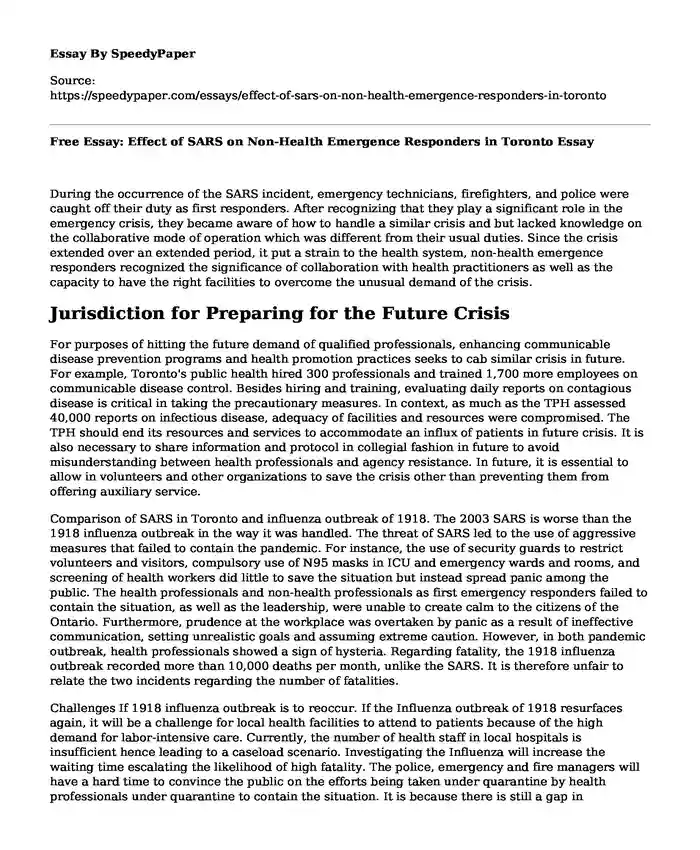
| Type of paper: | Case study |
| Categories: | Health and Social Care Homeland security |
| Pages: | 3 |
| Wordcount: | 597 words |
During the occurrence of the SARS incident, emergency technicians, firefighters, and police were caught off their duty as first responders. After recognizing that they play a significant role in the emergency crisis, they became aware of how to handle a similar crisis and but lacked knowledge on the collaborative mode of operation which was different from their usual duties. Since the crisis extended over an extended period, it put a strain to the health system, non-health emergence responders recognized the significance of collaboration with health practitioners as well as the capacity to have the right facilities to overcome the unusual demand of the crisis.
Jurisdiction for Preparing for the Future Crisis
For purposes of hitting the future demand of qualified professionals, enhancing communicable disease prevention programs and health promotion practices seeks to cab similar crisis in future. For example, Toronto's public health hired 300 professionals and trained 1,700 more employees on communicable disease control. Besides hiring and training, evaluating daily reports on contagious disease is critical in taking the precautionary measures. In context, as much as the TPH assessed 40,000 reports on infectious disease, adequacy of facilities and resources were compromised. The TPH should end its resources and services to accommodate an influx of patients in future crisis. It is also necessary to share information and protocol in collegial fashion in future to avoid misunderstanding between health professionals and agency resistance. In future, it is essential to allow in volunteers and other organizations to save the crisis other than preventing them from offering auxiliary service.
Comparison of SARS in Toronto and influenza outbreak of 1918. The 2003 SARS is worse than the 1918 influenza outbreak in the way it was handled. The threat of SARS led to the use of aggressive measures that failed to contain the pandemic. For instance, the use of security guards to restrict volunteers and visitors, compulsory use of N95 masks in ICU and emergency wards and rooms, and screening of health workers did little to save the situation but instead spread panic among the public. The health professionals and non-health professionals as first emergency responders failed to contain the situation, as well as the leadership, were unable to create calm to the citizens of the Ontario. Furthermore, prudence at the workplace was overtaken by panic as a result of ineffective communication, setting unrealistic goals and assuming extreme caution. However, in both pandemic outbreak, health professionals showed a sign of hysteria. Regarding fatality, the 1918 influenza outbreak recorded more than 10,000 deaths per month, unlike the SARS. It is therefore unfair to relate the two incidents regarding the number of fatalities.
Challenges If 1918 influenza outbreak is to reoccur. If the Influenza outbreak of 1918 resurfaces again, it will be a challenge for local health facilities to attend to patients because of the high demand for labor-intensive care. Currently, the number of health staff in local hospitals is insufficient hence leading to a caseload scenario. Investigating the Influenza will increase the waiting time escalating the likelihood of high fatality. The police, emergency and fire managers will have a hard time to convince the public on the efforts being taken under quarantine by health professionals under quarantine to contain the situation. It is because there is still a gap in communication integration among agencies, hence a posing a challenge of communicating balanced information about influenza. Although the police, emergency and fire managers will be working for long hours, they lack competence in to deal with influenza outbreak
Areas of Concern
Education and training of Non-health emergence responders
Availability of staff resources
Information reporting system
Availability of data
Adequacy of hospital facilities and resources
Cite this page
Free Essay: Effect of SARS on Non-Health Emergence Responders in Toronto. (2022, Feb 25). Retrieved from https://speedypaper.com/essays/effect-of-sars-on-non-health-emergence-responders-in-toronto
Request Removal
If you are the original author of this essay and no longer wish to have it published on the SpeedyPaper website, please click below to request its removal:
Popular categories




